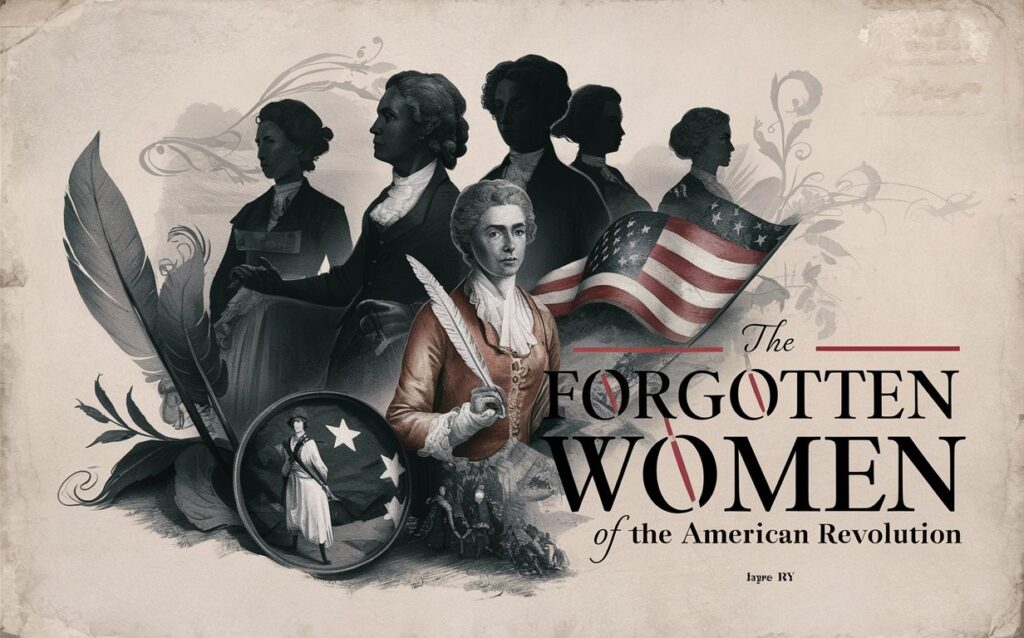The Forgotten Women of the American Revolution

When we think of the American Revolution, iconic figures like George Washington, Thomas Jefferson, and Benjamin Franklin often come to mind. However, the struggle for independence from Britain was not only fought on the battlefields by soldiers but also on the home front by a diverse group of men and women, many of whom have been largely forgotten by history. While women did not take up arms in the same way as their male counterparts, they played vital roles in supporting the revolution through espionage, nursing, fundraising, and even fighting. Their contributions were essential to the success of the revolution, yet their stories have often been overshadowed or erased by the dominant narratives of male heroism. In this article, we will explore the lives of some of the forgotten women of the American Revolution, highlighting their courage, resilience, and enduring legacies.
Women on the Frontlines: The Spies and Patriots
While women were generally not recognized as soldiers in the American Revolution, many fought in their own way by serving as spies, couriers, and secret informants. Their contributions were invaluable, often risking their lives to support the Continental Army and undermine the British forces.
Agent 355: The Mysterious Female Spy
Perhaps the most famous yet least known of the women spies was an enigmatic figure known only as Agent 355. She was a member of the Culper Ring, an espionage network organized by George Washington. Though her true identity has never been confirmed, it is believed that Agent 355 was an American woman living in New York City during the British occupation, and she played a key role in passing crucial information about British troop movements, plans, and intelligence. Her work was instrumental in providing Washington with information that helped secure American victories.
In a society where women’s involvement in espionage was often overlooked, Agent 355’s role was critical. She is believed to have been captured by the British toward the end of the war and died in captivity, but her contributions were integral to the success of American espionage efforts during the revolution.
Martha Washington: The First Lady of the Revolution
Martha Washington, the wife of George Washington, is often remembered as the first First Lady of the United States. However, her contributions to the American Revolution are frequently overshadowed by her husband’s political career. Martha played a critical role during the revolution, not as a soldier, but as a tireless supporter of the Continental Army and its soldiers.
During the harsh winter of 1777-1778, when General Washington and his troops were encamped at Valley Forge, Martha made frequent trips to the camp to provide support. She organized fundraising efforts, sent supplies, and worked alongside other women to help nurse the wounded soldiers. Her efforts were essential in maintaining morale during one of the most difficult periods of the war.
Martha Washington’s role as a morale booster and caregiver to the army was a vital part of keeping the soldiers’ spirits up during the long and bitter winter.
The Women Who Fought: Defying Gender Norms
While women were generally excluded from formal military roles, some brave women took up arms and fought in the Revolution, disguising themselves as men or otherwise defying societal expectations.
Deborah Sampson: The Soldier in Disguise
One of the most remarkable women of the American Revolution was Deborah Sampson, a Massachusetts native who disguised herself as a man in order to join the Continental Army. In 1782, Sampson enlisted under the name “Robert Shurtlieff,” serving in the 4th Massachusetts Regiment. She fought in several battles, including the Battle of Yorktown, and was wounded twice during her service.
Her identity as a woman remained a secret for much of her military career, but after being injured in battle, she was eventually discovered and honorably discharged. Despite the risks she faced, Deborah Sampson is one of the few women known to have fought in the war.
After the war, Sampson was recognized for her bravery, and in 1805, she was granted a military pension by the U.S. government, making her one of the first women in American history to receive such an honor.
Mary Ludwig Hays (“Molly Pitcher”): The Heroine of Monmouth
Another famous woman associated with the American Revolution is Mary Ludwig Hays, better known by her nickname Molly Pitcher. Hays earned her place in history for her actions during the Battle of Monmouth in 1778. Legend has it that when her husband, a cannon operator, was wounded during the battle, Molly took his place, loading and firing the cannon in his stead.
Molly Pitcher’s heroism at Monmouth became symbolic of the vital, if often invisible, role that women played in the war effort. While much of her story is wrapped in legend, her contributions to the Continental Army were significant, and she became an enduring symbol of courage and patriotism.
Women on the Home Front: Fundraisers, Nurses, and Domestic Support
While some women fought directly in the war, many others contributed to the cause through non-combatant roles. These women helped maintain the infrastructure of society, kept the economy running, and supported the Continental Army in practical and critical ways.
Phillis Wheatley: The Poet Who Inspired Patriots
Phillis Wheatley, a formerly enslaved African woman, is another often-forgotten figure from the Revolutionary era. Wheatley was an accomplished poet, and her work caught the attention of prominent figures like George Washington. In 1776, she wrote a poem praising Washington’s leadership, which he appreciated enough to acknowledge her in person.
Though Wheatley’s poetry is now widely celebrated, her story is often overlooked in discussions of the Revolution. She was one of the first African American women to have her work published, and her writing inspired many patriots to continue their struggle for freedom, even as they contended with the paradox of slavery in a nation founded on the ideals of liberty.
Abigail Adams: The Political Advocate
Abigail Adams, wife of John Adams and mother of future president John Quincy Adams, is perhaps one of the most politically active women of the Revolutionary period. Though not a soldier, Abigail played a significant role as an advisor and confidant to her husband, who was one of the leaders of the Continental Congress and later the second president of the United States.
Abigail was an outspoken advocate for women’s rights and was a vocal critic of British tyranny. She is perhaps most famous for her letters to her husband, in which she urged him to “remember the ladies” when creating the new laws and government of the United States. Her letters are a poignant reminder of the importance of women’s voices in shaping the nation, even if their contributions were often marginalized.
The Legacy of the Forgotten Women
The stories of the forgotten women of the American Revolution demonstrate the depth of female involvement in the struggle for independence. From spies and soldiers to caregivers and political advocates, women played indispensable roles in the revolution, yet their contributions have often been overlooked or minimized in the historical narrative.
By shedding light on the lives and actions of these women, we can gain a fuller understanding of the American Revolution as a collective effort that involved not just the men who fought on the frontlines, but the women who supported, sustained, and fought for the cause in ways both seen and unseen. The forgotten women of the Revolution were pioneers, advocates, and fighters in their own right, and their legacies continue to inspire today.
Conclusion: Remembering the Women of the Revolution
The American Revolution was a time of extraordinary change, and the contributions of women were crucial to its success. The women who played pivotal roles in the Revolution deserve to be remembered—not only as figures of historical importance but also as symbols of the courage, perseverance, and resilience that helped shape the United States. Whether in the form of espionage, battle, domestic support, or political advocacy, these women contributed to the ideals of freedom and independence that the nation was built upon. Their stories, though often forgotten, are as vital to understanding the history of the American Revolution as the men who led it.



Post Comment